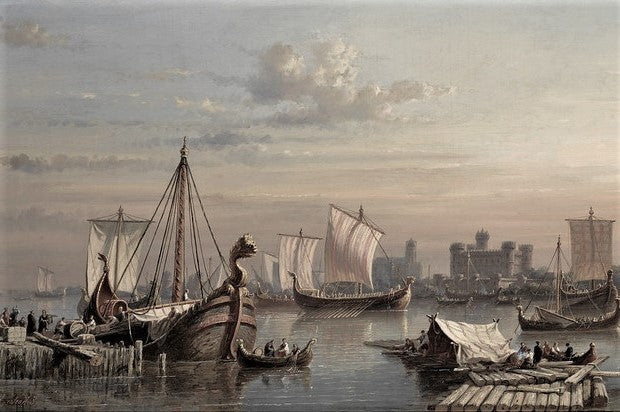History Of The Vikings - Chapter 1
History Of The Vikings
While Vikings are more prominently known to be savage raiders whose only past time was pillaging mercilessly in search for treasure and adventure. There's actually more to them than that. Between the eighth to eleventh century, Vikings were also known to be traders and explorers and not just the fierce warriors we all know them to be.
The term Viking can be credited to the Scandinavian term "vikingr" meaning pirate which is where the Vikings got their reputation. The first recorded Viking raid was dated back 793 where a group of seaborn Scandinavian pirates attacked a monastery in St. Cuthbert on Lindisfarne. It was said that they left very few survivors and hauled off with treasures and slaves. From here forth the stories started to spread like wildfire and with each story telling the tales grew more and more until the Scandinavians became the feared Vikings they are today. However, sadly, very few know of their complex and sophisticated culture filled with stories, magic and symbolisms.
Who are the Vikings and where did they come from?
It is important to note that originally the word Vikings was not meant to describe a group of people nor was it recognized as a nationality. The word Viking used to refer to a man who left his hometown to search for better opportunities elsewhere. The word held a much different meaning then than it does today.
Most Vikings (as we know them now) were originally from Scandinavia. Not to say that all Vikings were Scandinavians of course. In terms of physical features, Vikings were prominently stereotyped as blond and blue-eyed. However, majority of the Vikings tend to have light hair and light eyes of either blue, gray or green. This can be attributed to their heritage and combination of different races.

The Viking Age was the period between 800AD up until the 1050s. During this time, their reach extended to all corners of Northern Europe and many other nations surrounding their coasts. While we were made to believe that they were made up only of fierce warriors, in truth, they did more than just raiding. Vikings excelled in trading for goods like fur, tusks and seal fat while others were farmers. It is important that we recognize them as more than just raiders as the Vikings have also established themselves as traders and good story tellers.
Today the most obvious groups of Viking heritage would be the modern-day Scandinavians specific to those in Denmark, Sweden, Norway, Iceland and at some point, due to proximity Finland. However, as the name implies, a lot of them have also spread out across the globe and have settled elsewhere. Some known to have gone as far as Normandy, Russia, Greenland and even England. Who knows, you might even have a little piece of Viking heritage in you!
Led Zeppelin said it best when he sang Immigrant Song:
We come from the land of the ice and snow
from the midnight sun, where the hot springs flow!
The hammer of the gods
will drive our ships to new lands
to fight the horde, and sing and cry
Valhalla, I am coming!
The Viking Way of Life
While we know them to be merciless and adventure seeking Scandinavians, in truth Vikings were predominantly farmers and fishermen who lived in homes made with timber. Their homes were long and rectangular with roofs made of straw thatch. Their homes had no chimneys, only blacksmith's forge that allowed smoke to escape. Vikings dressed simply and with practical clothes made of either wool or linen along with leather shoes. Because Viking women were known to be skilled weavers, they made most of the clothes they wore. Making clothes was time consuming which was why clothing was considered valuable and should be made to last. Social classes could also be identified by the clothes they wore. Nobility and higher classes wore more expensive clothes made of silk. They also included accessories like brooches, jewelry and arm rings. Their clothes were more intricate in design and included more decorations and color. The middle- and lower-class Vikings dressed in more simple clothes as they dressed more for function than for fancy. Clothing was also different for men and women. Men wore tunics and loose skirts. Underneath they wore trousers. Women wore long dresses topped with an overdress. The only thing they had in common was that they secured their clothes with leather belts. During colder seasons, they wore long cloaks made of wool or animal skin. They also wore hats and mittens. Shoes were simple leather booties with soft soles secured by leather laces.
Salt was a commodity in the Viking world. They got this mostly through trade with nearby merchants. Salt was needed to preserve the fish they caught from nearby seacoasts. Some Vikings preferred to harvest crops and raise cattle. They also had their fair share of traders who earned their means trading with nearby cities.

In the early Viking Age, they did not have any recognized king. However, much like early England, they had three broad social classes. They had the nobles, the middle class and the slaves. As they continued to progress, they started forming leaders, the strongest ones became kings. They became the kings of Sweden, Norway and Denmark. They finally started to establish their hierarchy in the early 9th century.
Much like in today's society, Vikings can easily move from one social class to another. Slaves (often times called thralls) could save up enough over time to buy their freedom. On one hand, the nobles (often times called jarls) could easily loose their property or jewels and lower their status down to middle men (often times called karls) or if fortune does not go in their favor and they end up losing everything, they could even end up as slaves.
As the Viking age progressed, the same feudalism that governs European nations made the classes more rigid than it used to be. In truth, there's still so much that needs to be learned about early Viking society. All in all, they lived very simple lives.




Dejar un comentario